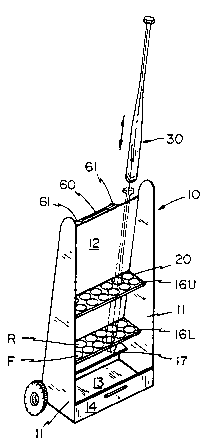Some of the information on this Web page has been provided by external sources. The Government of Canada is not responsible for the accuracy, reliability or currency of the information supplied by external sources. Users wishing to rely upon this information should consult directly with the source of the information. Content provided by external sources is not subject to official languages, privacy and accessibility requirements.
Any discrepancies in the text and image of the Claims and Abstract are due to differing posting times. Text of the Claims and Abstract are posted:
| (12) Patent Application: | (11) CA 2014206 |
|---|---|
| (54) English Title: | BAT RACK |
| (54) French Title: | RATELIER DE BATTES |
| Status: | Deemed Abandoned and Beyond the Period of Reinstatement - Pending Response to Notice of Disregarded Communication |
| (51) International Patent Classification (IPC): |
|
|---|---|
| (72) Inventors : |
|
| (73) Owners : |
|
| (71) Applicants : |
|
| (74) Agent: | MITCHES & CO. |
| (74) Associate agent: | |
| (45) Issued: | |
| (22) Filed Date: | 1990-04-09 |
| (41) Open to Public Inspection: | 1991-10-09 |
| Examination requested: | 1990-07-03 |
| Availability of licence: | N/A |
| Dedicated to the Public: | N/A |
| (25) Language of filing: | English |
| Patent Cooperation Treaty (PCT): | No |
|---|
| (30) Application Priority Data: | None |
|---|
TITLE
BAT RACK
APPLICANT
Kevin Michael Foley
INVENTOR
Kevin Michael FOLEY
ABSTRACT
A portable bat rack is generally shaped in the form of an equilateral triangle
with larger sides of the triangular subtending the front and back of the rack while the
smallest side subtends the bottom of the rack. The rack is closed at bottom and back
and along the sides and carries three laterally disposed shelves, the lowest shelf being
no greater than one half the width the other two shelves, the other two shelves
relatively disposed above the smallest shelf and defining a plurality of bat accomodating
apertures, preferably in an array of two parallel rows, a forward and rearward row.
The rearward row of openings allows bats placed therethrough to rest on the smallest
shelf while the forward row of openings allows the bats to rest on the bottom. The
rack includes a pair of wheels and handle means whereby it may be, on the one hand,
placed stationery on the ground to tip the bats forward and display them in two rows at
different elevations; alternatively pulled by a handle so as to roll over the ground or
allowing the same to be picked up and placed into a trunk of a vehicle with two
handles.
Note: Claims are shown in the official language in which they were submitted.
Note: Descriptions are shown in the official language in which they were submitted.

2024-08-01:As part of the Next Generation Patents (NGP) transition, the Canadian Patents Database (CPD) now contains a more detailed Event History, which replicates the Event Log of our new back-office solution.
Please note that "Inactive:" events refers to events no longer in use in our new back-office solution.
For a clearer understanding of the status of the application/patent presented on this page, the site Disclaimer , as well as the definitions for Patent , Event History , Maintenance Fee and Payment History should be consulted.
| Description | Date |
|---|---|
| Inactive: IPC from MCD | 2006-03-11 |
| Inactive: IPC from MCD | 2006-03-11 |
| Inactive: IPC from MCD | 2006-03-11 |
| Inactive: IPC from MCD | 2006-03-11 |
| Inactive: Inventor deleted | 2001-08-03 |
| Application Not Reinstated by Deadline | 1992-10-09 |
| Time Limit for Reversal Expired | 1992-10-09 |
| Inactive: Adhoc Request Documented | 1992-04-09 |
| Deemed Abandoned - Failure to Respond to Maintenance Fee Notice | 1992-04-09 |
| Application Published (Open to Public Inspection) | 1991-10-09 |
| All Requirements for Examination Determined Compliant | 1990-07-03 |
| Request for Examination Requirements Determined Compliant | 1990-07-03 |
| Abandonment Date | Reason | Reinstatement Date |
|---|---|---|
| 1992-04-09 |
Note: Records showing the ownership history in alphabetical order.
| Current Owners on Record |
|---|
| KEVIN M. FOLEY |
| Past Owners on Record |
|---|
| None |